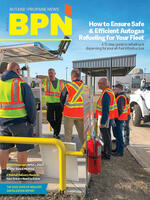
All companies working in the propane industry can have potential exposure to pollution-related incidents. To understand your company’s specific needs for pollution liability insurance coverage, this article includes 10 situations to help identify potential pollution-related exposures.
Before reviewing these situations, though, take a look at this five-step program to help management teams identify and remediate the full spectrum of business hazards.
1. Differentiate Between Business Risks & Hazards
To properly identify business hazards, insureds must first understand the difference between a risk and a hazard. While a risk involves potential exposure to danger, a hazard involves actual exposure to danger. For example, there is risk every time someone gets behind the wheel of a company-owned vehicle. A wet floor or a shelf that hasn’t been properly secured are hazards.
How can managers identify hazards at the workplace? Take a walk around the workplace to identify potential trouble spots. Ask employees to list hazards through face-to-face meetings or anonymous suggestion boxes. Schedule staff workshops. Engage with peers at professional association meetings and conferences. Familiarize yourself with key links in your supply chain. Read trade publications. Hire a professional risk expert. Maintain and refer to equipment repair and maintenance schedules.
2. Decide Who Might Be Harmed by Workplace Hazards & How
After identifying workplace hazards, the next step is for managers to understand whom they might harm. This can include employees working in your production facility or at a warehouse, clients visiting your office, clients or suppliers accessing your website after it has been infected by a virus, staff who drive while on company business, and clients for whom you serve as a supply chain link.
3. Evaluate Risks & Choose Control Measures
After identifying hazards, the next step is to determine how to protect all those who are at risk of being harmed. One obvious action is to remove hazards which can be reasonably eliminated. When a hazard cannot be entirely eliminated, steps should be taken to prevent injury by posting signs, stringing warning tape or taking similar actions. Of course, every effort must be taken to prevent any occurrence of injury.
4. Keep a Physical Record of Your Findings
Record findings and share them with affected members of your organization when it is appropriate. By recording an account of how management plans to either eliminate hazards or reduce the risk of their occurrence, there will be a physical record that hazards were identified, decisions were made about who could be harmed and how, and that a plan was executed to eliminate or mitigate the hazard.
5. Formalize a Process to Periodically Review & Update Your Hazard Assessment
Change is constant. This is true of the physical workplace, environmental factors including climate, the condition of machinery and other equipment, new or improved technology, employee skill level and experience, supply chains and clients. This even includes products and services; each time the insured adds or even modifies a product or service, a fresh risk can be added to the business.
Certain risks, such as cyber risk, didn’t even exist a short while ago. Consequently, a process must be in place by which the insured reviews and updates the risk assessment on an ongoing basis.
Identifying Uninsured Pollution Exposures
While it is recommended to engage a professional risk analyst to audit your company’s uninsured pollution exposures profile, take a moment to read through these ten situations that can happen in different types of workplaces to help you self-identify potential pollution-related exposures:
- An air compressor fails and the operating hydraulic fluid leaks, contaminating your property and/or causing bodily injury to a third party.
- An ammonia refrigeration system leaks, causing a disruption of your operations or those of a third-party facility, leading to a shutdown.
- A facility or adjacent business has a chemical leak causing the company to shut down for several weeks until the Environmental Protection Agency (EPA) deems it safe for employees to return to work.
- Gas or fluids are absorbed, causing a bodily injury or hypersensitivity allegation.
- A product “contaminates” another company’s product or another company’s manufacturing equipment.
- Process wastewater runs into a nearby stream.
- A fire at your facility creates smoke and a terrible odor, causing the surrounding residential neighborhood to allege impairment and file multiple lawsuits against your company.
- Dust from a cyclonic collecting tower is released, causing alleged bodily injury to a third party as well as extensive damage to your property. The EPA also mandates a cessation of operations during the cleanup process, which severely disrupts your revenue stream.
- Mold or legionella at your facility leads to lawsuits alleging bodily injury, the shutdown of the facility and lost profits, rents and reputation.
- Paint, or some other type of liquid substance (pollutant), runs off your facility into a nearby drain or stream.
Enlist the aid and guidance of your trusted insurance agent or broker regarding pollution-related exposures. If your business is not properly covered by insurance, it could be confronted with an expensive surprise.


